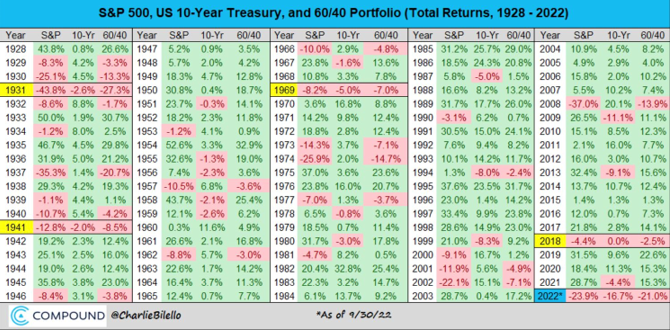The summer months took investors on a whirlwind ride of ups and downs, ultimately settling with most of our portfolio models flat to slightly down for the third quarter. Weakness in the U.S. equity market was more than offset by an incredibly strong performance by the U.S. dollar which rose more than 6% against the Canadian dollar! Domestically, the bond market had its first positive quarterly return of the year while the equity market lost just over 1%. European markets continue to struggle with energy supply problems which weighed on the broader international equity market returns resulting in the lowest quarterly return of the four main indices that we track, down about 3.5%.
From a headline perspective, not a lot has changed from the last quarter: central banks are still aggressively tightening; inflation levels remain unacceptably high; the conflict between Ukraine and Russia rages on; and COVID still gets a mention every once in a while. For the impatient investor, this is a challenging time as the duration of this down market is now the longest we have seen since the financial crisis that originated close to 15 years ago. And here’s the kicker: we expect the news will probably get worse before it gets better.
Even though central banks have been relentless in their bid to contain inflation for the better part of this year, economic data, especially in the U.S., has remained remarkably resilient and inflation is still at elevated levels. Corporations, for the most part, are still finding it difficult to hire, and massive layoff announcements have been limited to companies that arguably may just have been irresponsibly managed (case in point: https://www.cbc.ca/news/business/wealthsimple-layoff-markets-1.6489647). FYI, Justwealth is hiring! Corporate defaults have not moved up in any meaningful way, and consumer debt provisions have yet to have a significant negative impact on Canadian bank earnings. This is not typical anecdotal evidence of a “recession”.
It will take time for the full impact of central bank actions to show up in economic data, but it most certainly will. Real asset prices and financial asset prices have dropped sharply – that is not something that central banks address very often because it is not official economic data. But if people have less wealth, prices remain “expensive”, and borrowing becomes unaffordable due to high interest rates, something has to give…and it will be economic growth…which will, not coincidentally, force lower prices. It is impossible to predict when this will happen, but we do believe it will happen swiftly once it begins, especially since wealth levels are already depressed.
We are not predicting financial Armageddon here – far from it! We are predicting “worse news” to be forthcoming. As we stated in our last newsletter, a recession has already been priced into market levels so we do not fear “worse news”, we expect it, and do not believe it will send markets sharply lower. As evil as central banks are portrayed for imposing economic pain, we fully expect they will be Saviours if things get too bad as they have repeatedly been in the past.
It has been an unusual year in that both bonds and equities have had very negative returns thus far on a year-to-date basis. How bad has it been? The chart below updated to the end of September 2022 (source: Compound Capital Advisors) shows that it has been one of the worst years ever considering a 60/40 equity/bond asset allocation. Keep in mind that this is US data and the 10-Yr column is really a proxy for bond returns.

Canadian equivalent indices would not have been down as much for both equity and bonds, but the conclusion would be the same: it has been an abnormally bad year. As we often point out, one year is a very short period of time when taken in the context of an investor’s lifecycle of investing – almost meaningless in most cases. But even if annual performance is analyzed and meant something, it is worth noting that there are a lot more green annual numbers than there are red ones.
The other important point about this chart that might not be obvious to many investors is that the most comparable period on this chart to the high inflationary environment that we are in now would be 1980 – that is when abnormally high inflation last peaked. Based on these annual measurement points, not a lot of pain was experienced in these benchmark references in 1980, but look at what happened in the years following when inflation was effectively defeated: many, many years of sizable gains, particularly in bonds.
To be clear, we are not suggesting comparable returns will materialize in bonds, or the broader 60/40 portfolios as there are differences between then and now, but, the more that markets decline and interest rates increase, the more optimistic we feel about forward-looking returns. Internally, our projection for long-term bond returns is at the highest level it has been since our inception! To summarize, don’t get too wrapped up in the headlines…quite often bad news is an early sign of good things to come.
Here is a recap of market performance as of September 30, 2022*
| Asset Class | Market Index | Quarter | 1 Year | 3 Years | 5 Years | 10 Years |
| Fixed Income | FTSE TMX Canada Universe Bond | 0.52% | -10.48% | -2.51% | 0.66% | 1.65% |
| Canadian Equity | S&P/TSX Capped Composite | -1.41 | -5.39 | 6.59 | 6.54 | 7.30 |
| U.S. Equity | S&P 500 ($Cdn) | 1.32 | -8.32 | 9.51 | 11.31 | 15.50 |
| Int’l Equity | MSCI EAFE ($Cdn) | -3.45 | -18.80 | -0.61 | 1.05 | 7.19 |
* Source: Morningstar Direct. Performance annualized for periods greater than 1 year.

Comments are closed.